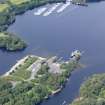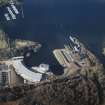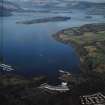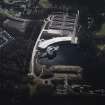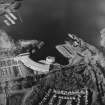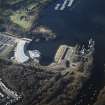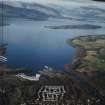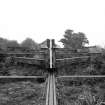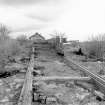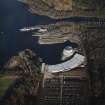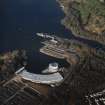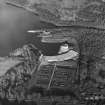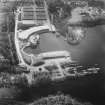Drumkinnon Bay, Balloch Pier, Slipway And Engine House
Slipway (19th Century)
Site Name Drumkinnon Bay, Balloch Pier, Slipway And Engine House
Classification Slipway (19th Century)
Alternative Name(s) Loch Lomond, Winch House
Canmore ID 127163
Site Number NS38SE 44
NGR NS 38554 82457
Datum OSGB36 - NGR
Permalink http://canmore.org.uk/site/127163
- Council West Dunbartonshire
- Parish Bonhill (West Dunbartonshire)
- Former Region Strathclyde
- Former District Dumbarton
- Former County Dunbartonshire
NS38SE 44 38554 82457
Balloch, slipway
(Undated) information in NMRS.
Slipway: A broad gauge railway consisting of cast-iron bridge rails on longitudinal sleepers, on which runs a wooden carriage, with outriggers for paddle box support. A central rail with ratchet teeth between gearing surfaces is also provided. In a recatngular harled brick building at the top of the building is a steam winch with a vertical boiler. Use for attention to the Loch Lomond steamers.
Visited and photographed by J R Hume, University of Strathclyde, 29 April 1971.
Information from MS/749 (Dunbartonshire, Bonhill parish, Slipway), photographs attached.
"...built c. 1899 by the Dumbarton & Balloch Joint Line Committee. A 2-track 'patent slip' , with a wooden cradle and iron outriggers supported on a double central rail, with ratchet in the centre, and single side rails. The rails are all of cast-iron, bolted to longitudinal sleepers, which are in turn held in gauge by widely spaced cross sleepers. At the head of the slip is a single-storey harled winding-engine house, containing a large steam winch."
J R Hume, 1976.
This slipway was used for the assembly, miantenance and repairs or cruise boats that operated on Loch Lomond. The slipway and engine house are not depicted on the 1st edition of the 25-inch map (Dunbartonshire, 1898, sheet XVIII.2), but is however, depicted on the OS 25-inch map of 1919 (Dunbartonshire, sheet XVIII.2).
At the time of survey, the yard was in the hands of the official receiver and was only viewed from a distance. The slipway carriage is a wooden structure and runs on 3 iron rails mounted on a concrete slipway. The haulage engine house is a single-storey, slate-roofed with ridge vent, over hanging eaves with red brick margins and rough cast walls.
Visited by RCAHMS (GJD) 12 May 1992.
NMRS MS/744/210/37.























